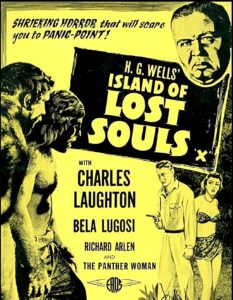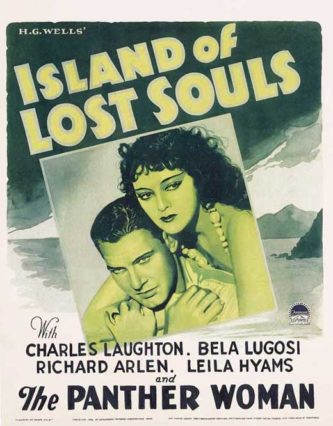 To fully appreciate this film one has to cast one’s mind back to 1932, when ISLAND OF LOST SOULS shocked audiences worldwide. Today, obviously, that shock value has long since worn off, but the film remains a visually impressive spectacle that actually outdoes it source material—THE ISLAND OF DR. MOREAU by H.G. Wells—in many respects.
To fully appreciate this film one has to cast one’s mind back to 1932, when ISLAND OF LOST SOULS shocked audiences worldwide. Today, obviously, that shock value has long since worn off, but the film remains a visually impressive spectacle that actually outdoes it source material—THE ISLAND OF DR. MOREAU by H.G. Wells—in many respects.
…the film remains a visually impressive spectacle that actually outdoes it source material…
THE ISLAND OF DR. MOREAU, published in 1896, was first adapted for the screen in 1911, in the French two-reeler ILE D’EPOUVANTE (THE ISLAND OF TERROR). Later versions include a trash film cycle from Filipino producer/director Eddie Romero—TERROR IS A MAN, BRIDES OF BLOOD, MAD DOCTOR OF BLOOD ISLAND, BLOOD DEVILS, TWILIGHT PEOPLE—and the 1977 and 1996 versions of ISLAND OF DR. MOREAU.
ISLAND OF LOST SOULS appeared in the midst of the early 1930s horror movie boom around the same time as FRANKENSTEIN, DRACULA, THE MUMMY and FREAKS. It didn’t have anywhere near the same impact as those classics, due in no small part to the fact that it was so widely censored; the film was banned in 11 countries and heavily shorn in many others. For years finding a complete print of ISLAND OF LOST SOULS was extremely difficult, and it took until 2011 for the film to be released on DVD in the US.
For years finding a complete print of ISLAND OF LOST SOULS was extremely difficult, and it took until 2011 for the film to be released on DVD in the US.
The burly Edward Parker, having survived a shipwreck, is taken aboard a freighter bound for a secluded island. Said island is inhabited by the mysterious Doctor Moreau, who is on the freighter together with his assistant Montgomery and some odd-looking men covered with fur. Parker gets into a spat with the freighter’s asshole captain, and is tossed onto a boat manned by Moreau and his minions.
Parker is taken back to Moreau’s island. There he’s introduced to Lota, a seductive woman who wears an ultra-skimpy two piece outfit. He also discovers the existence of several fur-covered men much like those seen on the freighter.
The beast men, it transpires, are human-animal hybrids surgically created by Moreau and Montgomery in their “House of Pain.” The same is true of Lota, who began life as a panther. Moreau wants Parker and Lota to mate and conceive children, and to facilitate this he sinks the boat that was to transport Parker away from the island. Parker nearly succumbs to Lota’s charms but good sense ultimately wins out.
…the film was banned in 11 countries and heavily shorn in many others.
That’s a good thing, as Parker’s fiancée Ruth travels to the island in search of her husband-to-be. Moreau tries to make Ruth the carrier of his unholy brood by having one of his beast men rape her, but his plan is thwarted once again.
Moreau’s world is further upset by the fact that, as he himself proclaims, the natives are growing restless (yes, this movie was the source of that cliché, which onscreen is rendered as “They are more than usually restless tonight”). Clearly, it’s not long before Moreau will be experiencing the horrors of House of Pain himself!
 ISLAND OF LOST SOULS is far from the “B movie” many have claimed it is. In fact, it was an expensive prestige production marked by impressively wrought set design, including the schooner of the early scenes and Moreau’s compound, and elaborate make-up effects that in 1932 were positively revolutionary.
ISLAND OF LOST SOULS is far from the “B movie” many have claimed it is. In fact, it was an expensive prestige production marked by impressively wrought set design, including the schooner of the early scenes and Moreau’s compound, and elaborate make-up effects that in 1932 were positively revolutionary.
Another quality component is the gorgeously nuanced cinematography by Karl Struss (of SUNRISE, SOME LIKE IT HOT and THE GREAT DICTATOR), who provides a hazy, misty sheen and a most striking use of shadow (the bars seen crisscrossing Moreau’s compound were an inspired touch). Also worthy of mention is the towering performance of Charles Laughton as the fatally smug and sadistic Dr. Moreau (perhaps the screen’s quintessential cackling villain), and Bela Lugosi makes a strong impression in his two scenes as the beastly “Sayer of the Law.”
For anyone who’s read H.G. Wells’ ISLAND OF DR. MOREAU, this film’s fidelity to it will be an issue. The screenplay, credited to Waldemar Young and science fiction legend Philip Wylie, follows the events of the novel reasonably closely but makes a number of additions. Some of those additions, such as the seductive Panther Woman (played by Kathleen Burke), are good, and some, such as Parker’s fiancée Ruth (Leila Hyams), are not-so; Ruth exists essentially to provide sex appeal (something that’s adequately derived from Ms. Burke’s Panther Woman) and a sense of normalcy (already provided by her husband, played by Richard Arlen). Wells, for the record, hated the film, which he felt over-relied on shock horror.
Speaking of which, I’m afraid none of the shocks that so impacted 1932 audiences remain in a film that would likely warrant a PG rating today. Luckily ISLAND OF LOST SOULS contains enough good things to make for a quality film even without the shock value.
Vital Statistics
ISLAND OF LOST SOULS
Paramount
Director: Erle C. Kenton
Screenplay: Philip Wylie, Waldemar Young
(Based on THE ISLAND OF DR. MOREAU by H.G. Wells)
Cinematography: Karl Struss
Editing: Fred A. Datig
Cast: Charles Laughton, Bela Lugosi, Richard Arlen, Leila Hyams, “The Panther Woman” (Kathleen Burke), Arthur Hohl, Stanley Fields, Paul Hurst, Hans Steinke, Tatsu Komai, George Irving
